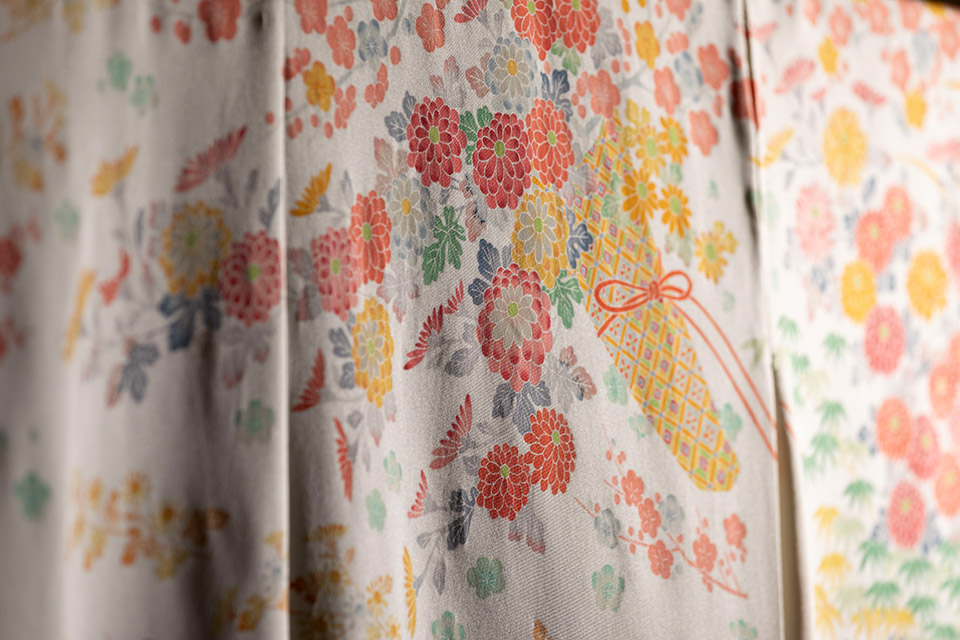
Here stood Chikiriya, a general trading company dealing kimono, in business for over three hundred years. These kimonos in Chikiriya collection will be on monthly display in the lounge at the lobby. Enjoy a once-in-a-lifetime encounter with an exquisite art piece.
Spring

March -
Furisode (long sleeved kimono), ‘Shiki no kachō (flowers and birds of four seasons)’
Birds and butterflies animate the landscape ornate with seasonal flowers of peony, plum, chrysanthemum, autumn foliage, bellflower and orchids. The batik technique to invigorate the brushwork and the embroidery with gold and white threads culminate in the beauty.
April -
Kaga yūzen furisode, ‘Yasurai matsuri (Yasurai festival)’
Yasurai festival, which convenes in April at Imamiya shrine, Kyoto, is depicted. It is mesmerizingly gorgeous with a large vermillion parasol scattered with seasonal flowers of cherry blossom, camellia, pine tree, chrysanthemum, wisteria, green maple and bamboo grass.
May -
Irotomesode (colored short sleeved kimono)
Against a light coral background colorful tanzaku (a wish-making strip of paper) with floral designs of peony, plum, bamboo grass, chrysanthemum, and orchid and patterns of cloisonne and diamond are displayed. It showcases the Batik technique to fully convey the artist’s brushwork and vigor.
Summer

June -
Irotomesode (colored short sleeved kimono), ‘Shikikachōzu (flowers and birds of four seasons)’
On a contrasting background of dark periwinkle and light wisteria towards the hem gold-thread embroidery adds a spark of luxury. Birds and river flow as yang (movement) element and flowers as ying (stillness) element are combined to show the scenery of four seasons.
July -
Tuzura (nail-scraping tapestry) maruobi ‘Gokakuzuishō’
On a bold checkerboard pattern in vermillion and white, a colorful design of five birds of crane, white gull, parrot, peacock and egret, as well as peony, orchid and pine tree is etched by nail-scraping technique called Tuzureori.
August -
Houmongi (semi-formal attire), ‘Nami (waves)’
A scene of the morning sun glittering on incessant coming and going of waves is expressed by Batik technique. Elaborated stages of batik dyeing repeated as many as the number of the waves therein amount to the depth of the completed work.
Fall

September -
Kaga yūzen furisode ‘Shunjūkizu (spring and autumn bliss)’
Against a celadon green background flowers of four seasons, such as chrysanthemum bouquet, nandina, plum, bamboo grass and camellia are lavishly illustrated. Such a refined art of itome yūzen is said to be extinct by now, having used extremely fine lines for placing glue to separate colors.
October -
Kaga yūzen furisode ‘Hanaguruma (flower cart)’
A Kaga yūzen emblem of fine delineating lines between colors allows delicate and colorful expression to make a breath-taking furisode. A lovely array of plum blossoms fills around the flower cart with assorted flowers.
November -
Furisode ‘Kyo no niwa (gardens in Kyoto)’
On large slanted swastika motif, woven in the vivid vermilion fabric, gardens in Kyoto, including Kinkakuji temple, are encapsulated on the fans. It is a one-of-a-kind furisode with Batik technique capturing the lively brushwork along with gold ornaments.
Winter

December -
Kurotomesode ‘Fuji ni tsuru (Tancho on Mount Fuji)’
It is a black short-sleeved kimono with an auspicious design of three tanchōzurus flying over the sea of clouds on Mount Fuji. Demonstrated in the blurred crimson near the hem is the color scheme original to Minagawa, Gekka, and so is the bold stroke of brush.
January -
Kurotomesode (black short sleeved kimono) ‘Matsu ni tsuru (cranes on pine tree)’
Black short sleeved kimono is a formal attire suitable for celebrations. It is adorned with an auspicious pattern of lively tanchōzuru (Japanese crane) at the backdrop of pine trees. A lavish use of color and gold threads, typical to Kishimoto, Keishun, gives dimensions to the Japanese embroidery.
February -
Maruobi (tubular kimono belt) ‘Zuichōfu (collection of auspicious birds)’
It is a double-width kimono belt with all the designs and patterns embroidered. It depicts birds of good omens such as peacocks, parrots, and ducks. They are surrounded by blossoms of plum, gingko, peony, chrysanthemum and orchid, depicted in an unobtrusive embroidery technique.













